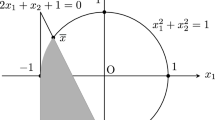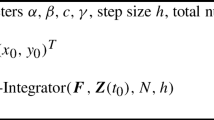Abstract
Letf: ℝn → (−∞, ∞] be a convex polyhedral function. We show that if any standard active set method for quadratic programming (QP) findsx(t)= arg min x ¦x¦2/2+t f(x) for somet> 0, then its final working set defines a simple equality QP subproblem, whose Lagrange multiplier can be used both for testing ift is large enough forx(t) to coincide with the normal minimizer off, and for increasingt otherwise. The QP subproblem may easily be solved via the matrix factorizations used for findingx(t). This opens up the way for efficient implementations. We also give finite methods for computing the whole trajectory {x(t)} t ≥0, minimizingf over an ellipsoid, and choosing penalty parameters inL 1QP methods for strictly convex QP.
Similar content being viewed by others
References
Benveniste R (1981) One way to solve the parametric quadratic programming problem. Math Programming 21:224–228
Best MJ (1982) An algorithm for the solution of the parametric quadratic programming problem. Research Report CORR 82-24, Department of Combinatorics and Optimization, University of Waterloo, Waterloo, Ontario
Best MJ (1984 Equivalence of some quadratic programming algorithms. Math Programming 30:71–87
Best MJ (1993) An algorithm for the solution of the parametric quadratic programming problem. Technical Report, Department of Combinatorics and Optimization, University of Waterloo, Waterloo, Ontario (revised version in preparation)
Boot JCG (1963) On sensitivity analysis in convex quadratic programming problems. Oper Res 11:771–786
Clark DI, Osborne MR (1983) A descent algorithm for minimizing polyhedral convex functions. SIAM J Sci Statist Comput 4:757–786
Dantzig GB, Orden A, Wolfe P (1955) The generalized simplex method for minimizing a linear form under linear constraints. Pacific J Math 5:183–195
Ferris MC, Mangasarian OL (1991) Finite perturbation of convex programs. Appl Math Optim 23:263–273
Fiacco AV (1983) Introduction to Sensitivity and Stability Analysis in Nonlinear Programming. Academic Press, New York
Fletcher R (1987) Practical Methods of Optimization, 2nd edn. Wiley, Chichester
Fletcher R (1991) Resolving degeneracy in quadratic programming. Numerical Analysis Report NA/135, University of Dundee, Dundee
Gill PE, Murray W, Saunders MA, Wright MW (1991) Inertia-controlling methods for quadratic programming. SIAM Rev 33:1–36
Grigoriadis MD, Ritter K (1969) A parametric method for semidefinite quadratic programs. SIAM J Control Optim 7:559–577
Hiriart-Urruty J-B, Lemaréchal C (1993) Convex Analysis and Minimization Algorithms. Springer-Verlag, Berlin
Jittorntrum K (1984) Solution point differentiability without strict complementarity in nonlinear programming. Math Programming Study 21:27–138
Kiwiel KC (1986) A method for solving certain quadratic programming problems arising in nonsmooth optimization. IMA J Numer Anal 6:137–152
Kiwiel KC (1989) A dual method for certain positive semidefinite quadratic programming problems. SIAM J Sci Statist Comput 10:175–186
Kiwiel KC (1990) Proximity control in bundle methods for convex nondifferentiable minimization. Math Programming 46:105–122
Kiwiel KC (1994) A Cholesky dual method for proximal piecewise linear programming. Numer Math 68:325–340
Kiwiel KC (1994) Finding normal solutions in piecewise linear programming. Technical Report, Systems Research Institute, Warsaw
Kiwiel KC (1995) Proximal level bundle methods for convex nondifferentiable optimization, saddle-point problems and variational inequalities. Math Programming, to appear
Lemaréchal C, Nemirovskii AS, Nesterov YuE (1995) New variants of bundle methods. Math Programming, to appear
Lucidi S (1987) A finite algorithm for the least two-norm solution of a linear program. Optimization 18:809–823
Lucidi S (1987) A new result in the theory and computation of the least-norm solution of a linear program. J Optim Theory Appl 55:103–117
Malanowski K (1987) Stability of Solutions to Convex Problems of Optimization. Lecture Notes in Control and Information Systems, Vol 93. Springer-Verlag, Berlin
Mangasarian OL (1981) Iterative solution of linear programs. SIAM J Numer Anal 18:606–614
Mangasarian OL (1984) Normal solutions of linear programs. Math Programming Stud 22:206–216
Mangasarian OL, De Leone R (1988) Error bounds for strongly convex programs and (super)linearly convergent iterative schemes for the least 2-norm solution of linear programs. Appl Math Optim 17:1–14
Mangasarian OL, Meyer RR (1979) Nonlinear perturbation of linear programs. SIAM J Control Optim 12:745–752
Mongeau M (1991) Discontinuous Piecewise Linear Optimization. PhD thesis, University of Waterloo, Waterloo, Ontario
Mongeau M, Sartenaer A (1993) Automatic decrease of the penalty parameter in exact penalty function methods. Report 93/02, Facultés Universitaires de Namur, Namur
Osborne MR (1985) Finite Algorithms in Optimization and Data Analysis. Wiley, Chichester
Ritter K (1967) A method for solving nonlinear maximum-problems depending on parameters. Naval Res Logist Quart 14:147–162
Ritter K (1981) On parametric linear and quadratic programming problems. MRC Technical Summary Report 2197, University of Wisconsin, Madison, WI
Rockafellar RT (1970) Convex Analysis. Princeton University Press, Princeton, NJ
Ryan DM, Osborne MR (1986) On the solution of highly degenerate linear programs. Math Programming 41:385–392
Schramm H (1989) Eine Kombination von Bundle- und Trust-Region Verfahren zur Lösung nichtdifferenzierbarer Optimierungsprobleme. Bayreuther Mathematische Schriften, Heft 30. Universität Bayreuth, Bayreuth.
Tikhonov AN, Arsenin VYa (1974) Methods for Solving Ill-Posed Problems. Nauka, Moscow. English transl (1977) Solutions of Ill-Posed Problems. Wiley, New York
Wolfe P (1959) The simplex method for quadratic programming. Econometrica 27:382–398
Wolfe P (1963) A technique for resolving degeneracy in linear programming. J SIAM 11:205–211
Author information
Authors and Affiliations
Additional information
Communicated by J. Stoer
This research was supported by the State Committee for Scientific Research under Grant 8S50502206.
Rights and permissions
About this article
Cite this article
Kiwiel, K.C. Finding normal solutions in piecewise linear programming. Appl Math Optim 32, 235–254 (1995). https://doi.org/10.1007/BF01187901
Accepted:
Issue Date:
DOI: https://doi.org/10.1007/BF01187901
Key words
- Convex optimization
- Quadratic programming
- Active set methods
- Sensitivity analysis
- Nondifferentiable optimization methods




